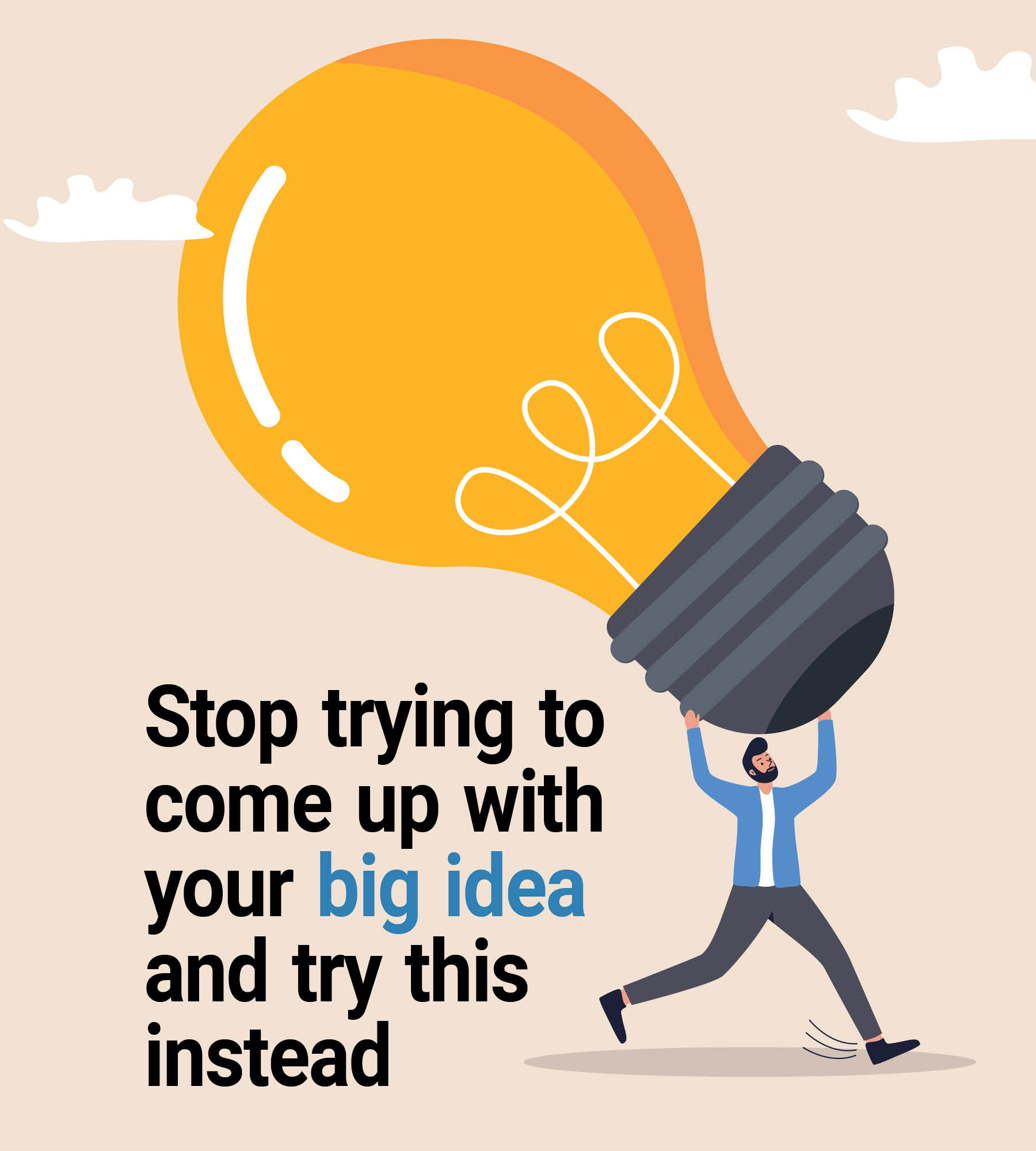Language
You can read the magazine in one of the following languages
Geolocation
You can read the global content or the content from your region

At a certain point in life, you realize you’re never going to be a rock star. You pack away your shiny dreams of being an A-list celebrity, along with the fanciful notion of becoming ‘the next big thing.’
Perhaps you thought you were going to invent something amazing and impress the investors on Shark Tank or Dragons’ Den with those new self-cleaning underpants or that revolutionary blend of kumquat soup.
But now, you grunt when you get up off the sofa, and you have pairs of socks older than most of the entrepreneurs online and you’re thinking, “My chance has slipped away.”
But has it?
The truth is that it’s often the pressure to come up with a big idea that stops us in our tracks. We’re racking our brains trying to think of something so new, innovative and revolutionary that it causes our brain to fog over, and we achieve nothing.
In my experience, the amazing superstars, the ingenious inventors and the big idea stories are few and far between. The true genius is in the little idea – taking something small that already kind of works and making it better.

The true genius is in the little idea – taking something small that already kind of works and making it better.
Looking at something you already offer and finding a new way to deliver it.
Here’s your permission to stop searching for some big momentous idea and start with something small instead. And here’s how to do it.
It’s all very well and good to want to help other people, but of course, we must rummage around to find our own oxygen mask first. What’s in it for you?
In my new book, Six Figures While You Sleep, I explain how I turned my skills and services into passive income digital products. And when I asked people why they wanted to come up with a passive income idea, they gave these reasons:

Right now, you might not have an altruistic reason, and that’s fine – but long-term you’re going to need something more than cold, hard cash to keep you going. What is your bigger purpose?
Perhaps you want to:
Think about what frustrates you about how you work. Perhaps it’s being asked the same questions again and again, or how long it takes your clients to give you the information you need. Perhaps it’s the time you spend onboarding new people, or how difficult it is to justify your prices.
There are gems in those frustrations. For example, if you’re frustrated by lots of questions, then the solution could be a community or FAQ bank where all those questions are covered. If you’re frustrated by onboarding struggles, then you could use a checklist of assets that need to be gathered and a tutorial on how to do it faster.

You can also think about what frustrates you about your industry. For me, I felt the SEO industry was full of cowboys and those pretending that it’s some dark art or genius-level process that only gurus can master.
This frustrated me, and I saw the need for an honest, plain-English SEO course that normal humans could master. And my ‘Recipe for SEO Success’ course was born.
Now, there may be absolutely nobody offering what you’re planning on offering. When I started my SEO course there were only a few others worldwide. There were also no courses at that time offered by a female SEO expert, and none that made SEO fun – and, at times, funny.
If you’re a true pioneer, the land before you is empty to travel as you wish, but you’re going to have to tread your own path. However, if similar products already exist, it doesn’t mean all is lost.

Look at what’s out there already and see how you could make it better.
Look at what’s out there already and see how you could make it better. Perhaps there’s already a course teaching people how to use a certain software, but it’s general and not specific to your industry. Maybe there’s a beginner-level offering, but you could offer advanced, or vice versa.
There’s also potential for finding ideas in one market that aren’t tailored to your market. For example, you’ve seen there’s a subcontracting agreement for copywriters, but you can produce one that’s perfect for graphic designers.
A few of my students have taken what they learned in my SEO course and created similar Spanish and German-language versions – obviously not out-and-out copying me, but adding their own ideas and flavor.
OK, so far, we’ve been super practical, but now I’m going to let you dream a little. Imagine you’re one year down the track and your passive income idea working – what does this look like?
Take your customer avatar and describe what you’ve helped them do, how they feel and what improvements have your products brought to their life. You can even take it a step further and write out your dream customer testimonial.
I know it’s a bit woo-woo, but it’s a nice exercise to give you the good feels. Even better, soon you’ll be able to compare that made-up testimonial to the real thing.
Any time you invest in planning your ideas will save you months, and possibly years, of effort and disappointment down the track. It will enable you to create something that flies off the virtual shelves and that you enjoy delivering.
OK, it’s over to you. What big little idea can you come up with?

Kate Toon
Contributor Collective Member
Kate Toon is an award-winning entrepreneur, bestselling author, educator, podcaster and parent to one human and one fur baby. From her humble backyard shed she masterminds an ambitious business universe, helping thousands build their own version of success through digital marketing, copywriting, SEO and business know-how. As the Founder of the Digital Marketing Collective and the Recipe for SEO Success, Kate has built a seven-figure business on passive-income digital products such as courses, resources, communities, masterminds and events. She’s the author of ‘Six Figures in School Hours’ and ‘Six Figures While You Sleep’. For more information visit https://www.katetoon.com/writing/books/six-figures-while-you-sleep/